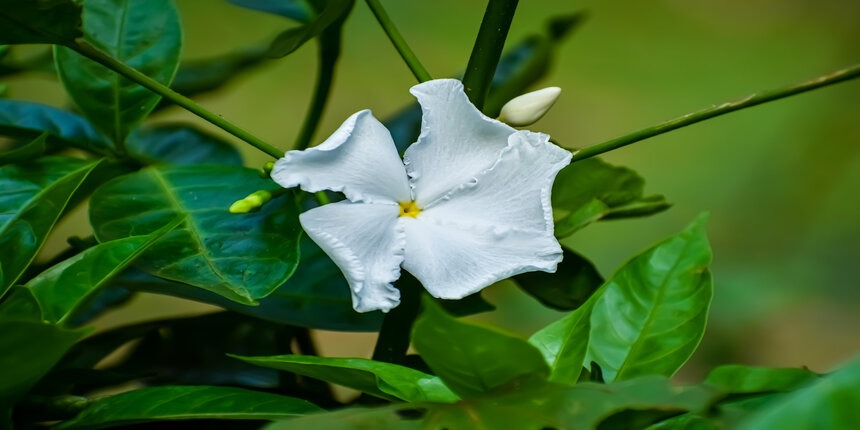Even though it is possible to be misled by the name, the Crepe Jasmine (Tabernaemontana Divaricata) is not actually a Jasmine. Throughout history, all white flowers with a sweet fragrance were referred to as a Jasmine. Infact, the Crepe Jasmine tree is actually a part of the Apocynaceae family. This family can be described as a family of plants that bleed milky fluid when broken. These plants usually bloom during the spring time and bear generous white fragrant flowers. The flowers usually have 5 petals which are arranged in a pinwheel design.
The flowers of these plants are usually 6 inches in length and have a very shiny texture. This makes these plants a perfect focal point for your shrubbery hedge. Proper trimming and pruning can also make the crape jasmine look like a small tree, which makes it a wonderful addition in any garden. Proper maintenance can also make these plants perfect to be planted as much as 3 feet close to your window sill, ensuring that you always have sweet smelling and fresh air.
Crepe Jasmine Growing Guide

If allowed to grow freely and wildly, the crepe jasmine has the ability to grow into a proper tree. On the other hand, if properly taken care of and pruned regularly, they can also be used as potted plants for your home interiors. If you plant these flowers with a gap of 3 feet between them, they can be the perfect hedge plants. Let’s take a look at some of the factors that may help you grow your very own healthy crepe jasmine plants.
Ideal Temperature for Growth
The usual blooming season for the crepe jasmine plant is during the period between spring to fall. In India, these plants bloom beautiful white flowers during the period between March and October. Being a tropical plant, these plants are more accustomed to slightly warmer and moist climates.
Sunlight Requirement
The crepe jasmine plant is the happiest when it is getting ample sunlight. They grow very healthy and happy when they get regular full sun or partially shade conditions. Not getting enough sunlight can be detrimental to the growth of the plant. If kept in complete shade inside your home may result in a plant that is stunted in growth. The ideal practice would be to keep your crepe jasmine plant in an area where it will get approximately 6-7 hours of direct sunlight.
What is the Best Soil Type?
Owing to the hardy and wild nature of these plants, they can grow in any type of soil. The only condition being that the soil should have strong drainage characteristics. If the soil is not well drained, it can cause the plant’s root to rot. The ideal soil pH level for this plant is between 4.6 to 6, which means that this plant prefers soil that is slightly on the acidic side. If the crepe jasmine plant is planted in alkaline soil, there is a possibility that it might develop Chlorosis. Furthermore, if your soil has more clay content, using cow dung compost and sand can help in improving drainage.
What Fertilizers Should You Use?
Like all other flowering plants, the crepe jasmine needs a steady amount of phosphorus and nitrogen to ensure healthy and lush foliage. The ideal time to start fertilizing these plants is between the months of September and February. The best fertilizer mix for these plants are the ones made of cow dung compost, dry leaf, bone meal powder, and neem cakes. Further, you should also use liquid fertilizer on the plant every 15 days. Although, if you are sceptical about using chemical fertilizers, the cow dung mixture should work just fine.
Uses of Crepe Jasmine
The crepe jasmine plant or Tabernaemontana Divaricata has a number of uses in medicine. This flower is used to make many pharmaceutical products,medicines, and even food products. Some of the uses of the plants are as follows:
- It has been used to treat a number of liver related medical conditions
- It can induce relaxation and help in preventing strokes
- It is a natural analgesic that is used in many skin treatment products
- It can help in speeding up the natural wound healing process
- This plant is also used for the manufacturing of creams, lotions, and perfumes
How to Repot and Prune Crepe Jasmine

Since this beautiful plant is predominantly a hedge plant, you can maintain the height and shape of the plant by making sure that it is trimmed and pruned properly. Growing these plants in small containers may lead to them being too root bound. Periodic checking of the root systems and light pruning of the root system ensures the long and happy life of the plant. The following are 2 of the most widely used methods of root pruning:
- If you wish to grow a full-size plant, separate the root bowl and place it in a container bigger than the previous one. This will ensure that the roots have ample space to grow and spread
- For a small sized plant, you should opt for a small bonsai sized container. Separate the root bowl from the container and prune it to the size of your bonsai pot.




